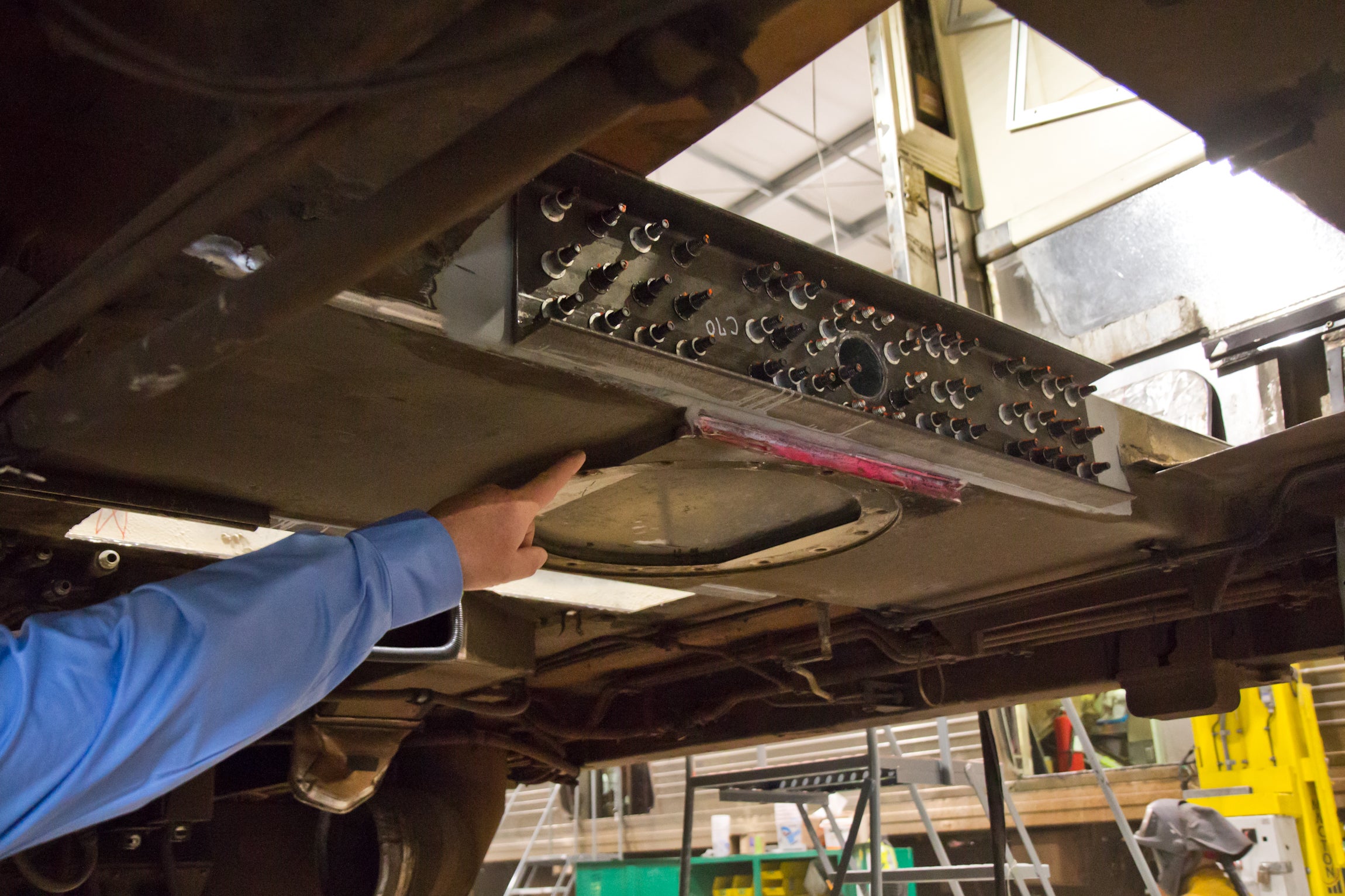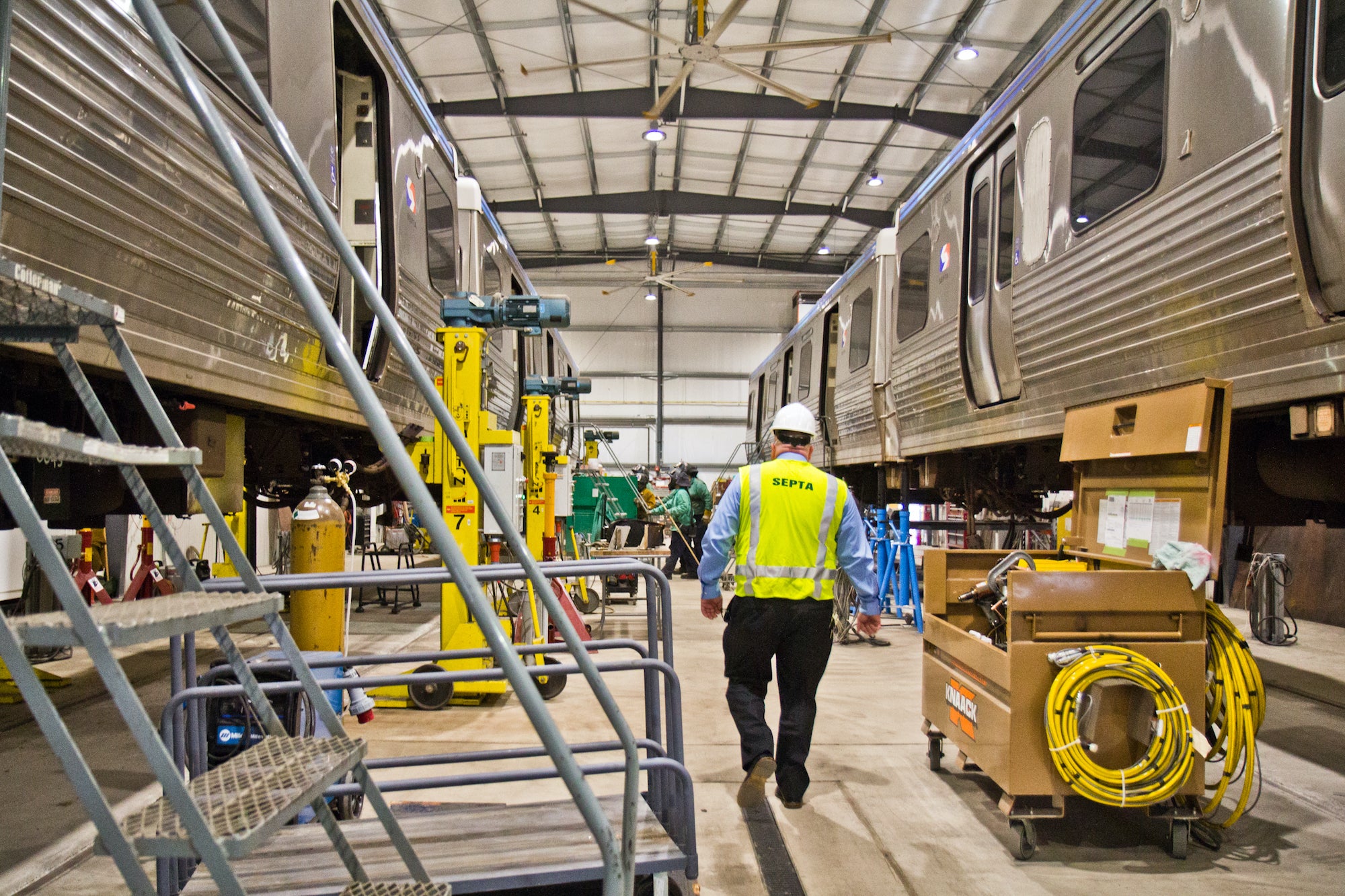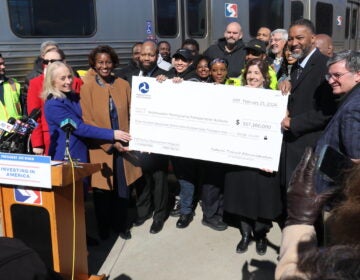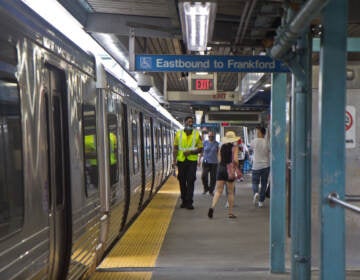SEPTA spends millions to fix cracking subway cars with ‘hoagie’ of steel
Transit agency SEPTA is spending millions more to fix cracking steel beams inside subway cars on the Market-Frankford Line, straining the line’s capacity.

Two Market-Frankford Line cars lifted for repairs at the 69th Street SEPTA repair shop. (Kimberly Paynter/WHYY)
Subway car defects and increased ridership are pushing SEPTA’s Market-Frankford Line close to a breaking point — and the agency is spending millions to keep the trains moving.
Officials told PlanPhilly that new efforts to fix a years-old problem with cracking steel beams inside the line’s M-4 subway cars have left the transit agency with just enough functional vehicles to operate on schedule during peak hours.
The elevated subway — or “the El” — is the system’s most used line, serving 180,000 riders on an average weekday between the Frankford Transportation Center and 69th Street in Upper Darby, including stops at City Hall and 30th Street Station.
Cracking steel has plagued El cars since at least 2017 when about 90 of the 1990s-era cars were pulled off the route for emergency welding work. But now all 218 cars in the fleet will need a more permanent fix, even those that received repair work three years ago.
“We knew at that time we were going to have to find a permanent fix down the road,” SEPTA spokesperson Andrew Busch said. “It was expected that the repairs would be good for a couple of years. But we’ve had instances where we applied that weld and cracks reappeared.”
The ‘hoagie approach’
SEPTA invested $3.3 million last fall in the construction of a specialized repair facility for the cracked cars at 69th Street Transportation Center in Upper Darby. The agency will spend an additional $15 to $18 million over the next five to six years to perform specialized repairs designed to permanently fix the problem.
The process, developed with consultant LTK Engineering Services, involves sandwiching defective beams between two new steel plates. Repair crews have dubbed it ‘the hoagie approach,’” Busch said.
So far, they’ve fixed 15 cars.
But until the subway cars are properly hoagie-fied, SEPTA will have to juggle already limited number of M-4 cars available for daily use — and also handle increased frequency and ridership demands.
He said that SEPTA needs all of its 138 operational M-4 cars to run the line at rush hour, but more than 30% of the entire MFL fleet is out for either steel beam repairs, regularly scheduled five-year overhauls, seat reconfiguration or other types of maintenance.
For comparison, only about 15% of the 1980s-era Kawasaki cars that traverse the Broad Street Line are out for service at any given time. Busch attributed the disparity to M-4 trains being built in “married” sets of two inseparable cars.
But retired University of Pennsylvania transit professor Vukan Vuchic, who planned SEPTA’s regional rail network, said the lack of spare cars was surprising. When SEPTA purchased the cars in 1997, Vuchic thought the agency had bought more than it would ever be able to use.
“This is unusual, that you would only have 138 out of 218 cars in service,” he said. “For rail cars, their life can easily be 40 years. Such major problems should not happen earlier than that.”

Few cars, growing congestion
Joe Coccio, secretary-treasurer with the Transit Workers Union Local 234, which represents most of SEPTA’s drivers and other blue-collar employees, said the dwindling number of spare cars is affecting service on the line.
“[Our] mechanics have been literally dedicating all of their free time working to ensure the safety of the riding public,” he said. “There is no doubt, the complicated repairs being done to address the cracks…are one of the primary reasons for Market-Frankford Line delays.”
MFL commuter Shelby Guercio also said she’d noticed more packed rush-hour trains and platforms in recent years.
“Sometimes, I would go down into 11th Street station around 5 p.m. and I would wait until 6:30 p.m. for a train that wasn’t packed. The trains were just so crowded,” said Guercio, who regularly takes the line from Center City from Fishtown. “There weren’t enough trains to carry all of the people that needed to get from Center City during rush hour.”
Limited relief on way
Busch said SEPTA has taken small numbers of cars out of service — four each month — for the “hoagie” repair in order to minimize service disruptions. But he acknowledged overall ridership has grown in recent years — with stations on the periphery of Center City seeing upwards of 25% ridership increase between 1996 and 2016 — taxing the battered fleet.
“The ridership on the line has grown and is very strong in general. Sometimes, during peak hours, we do run into capacity issues,” he said. “It’s a very busy line, our busiest line. And it goes through parts of the city that have seen tremendous growth in recent years.”
Busch said capacity issues had been taken into account for recent decisions to end to long-running skip-stop service on the MFL and run more trains during weekday evenings, which aim to ease congestion issues. He said that the limited number of spare cars was not expected to disrupt these plans.

He added that ongoing beam repair work would eventually have the long-term benefit of allowing the agency to push use of the M-4 cars through 2050, about a decade past their ordinary lifespan.
“We think with this repair we’ll get 30 more years of service,” he said.
But transit advocacy groups are calling for the agency to invest more in anticipation of growing ridership on the MFL. Justin Roczniak, a member of the Philly Transit Riders Union, an advocacy group, urged SEPTA to move up the timeline to purchase modern rail cars for the agency’s core urban transit lines.
“West Philly is growing. Fishtown, and all these other places, are growing. But this line is already at capacity,” he said. “It sounds a lot like that trolley modernization plan that’s not happening until 2030. Stuff just keeps getting pushed off and pushed off.”
Busch said the agency is instead currently searching for funding to pay for the construction of longer MFL platforms that would, in turn, allow for longer trains and accommodate more passengers.
But he said even this improvement would be costly and that the agency was limited by the size of its projected $675 million 2020 capital budget. There is little new funding on the horizon and some $450 million in statewide public transport funding from the Pennsylvania Turnpike is in jeopardy.
“Our funding constraints are well documented. Our capital budget is in the range of $600 to 700 million a year. When you look at peer agencies like Boston or D.C., it’s double that or more,” he said. “We just don’t have that in the capital budget.”
WHYY is your source for fact-based, in-depth journalism and information. As a nonprofit organization, we rely on financial support from readers like you. Please give today.







